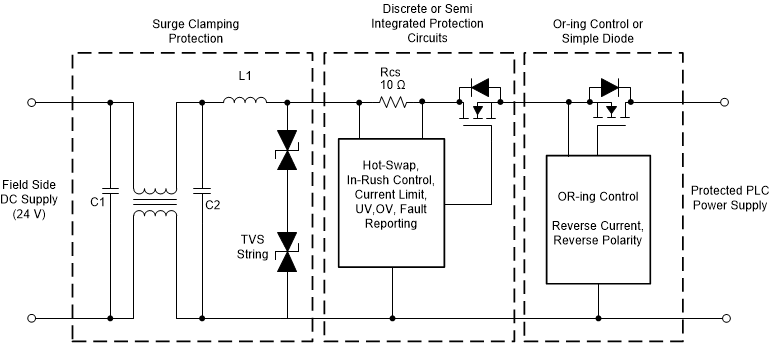-
Simplifying EFT, Surge and Power-Fail Protection Circuits in PLC Systems
- Trademarks
- 1 Surge Test (IEC 61000-4-5)
- 2 EFuse Solution for Surge Protection
- 3 EFuse Solution Schematic for Surge Protection
- 4 Circuit Performance for Surge Tests
- 5 EFT Test (IEC 61000-4-4)
- 6 EFuse Solution Schematic for EFT protection
- 7 Circuit Performance for EFT Tests
- 8 Power-Fail Test (IEC 61000-4-29)
- 9 EFuse Solution Schematic for Power-Fail Applications
- 10Circuit Performance for Power-Fail Tests
- 11EFT, Surge and Power-Fail Test Setup
- 12Conclusion
- 13References
- 14Revision History
- IMPORTANT NOTICE
Simplifying EFT, Surge and Power-Fail Protection Circuits in PLC Systems
Trademarks
All trademarks are the property of their respective owners.
1 Surge Test (IEC 61000-4-5)
The surge test is performed to make sure the system is immune to surges produced by lightning strikes and power system transients such as capacitor bank switching, short circuits and arcing faults. Surge testing is one of the highest energy pulse tests done on the system.
Typical traditional surge and front-end protection circuits used in a PLC system are shown in Figure 1-1. Input side passive components like common mode choke, series inductor and capacitors are used to reduce slew rate of the surge pulse. A string of TVS diodes is used to clamp the surge magnitude to an acceptable level. A series diode or an OR-ing controller with an external FET is used to protect the downstream from negative voltages. Negative voltages are most common either due to miswiring or a negative surge pulse. Discrete or semi-integrated solutions are used for hot-swap, inrush control, monitoring, undervoltage (UV) and overvoltage (OV) protection.
 Figure 1-1 Traditional Input Protection
Circuits
Figure 1-1 Traditional Input Protection
CircuitsFigure 1-2 shows catastrophic damage of the board due to protection circuits failure. Probability of the failure is high in a discrete components-based implementation. Selecting a proper integrated protection solution is critical to avoid possible system failure, unwanted downtime and bad reputation of the product.
 Figure 1-2 Impact of the Improperly
Designed Protection Circuits
Figure 1-2 Impact of the Improperly
Designed Protection Circuits2 EFuse Solution for Surge Protection
 Figure 2-1 EFuse Integrated Solution
Figure 2-1 EFuse Integrated SolutionThe eFuse-based surge protection solution is shown in Figure 2-1. It requires only a single TVS diode to protect the PLC from surges. The device does not need any passive wave shaping circuits to reduce slew rate of the surge. It can handle slew rates as fast as 20 V/µs. Built-in back-to-back FETs and reverse polarity protection circuits effectively block negative voltage that can be generated due to a negative surge.
The ±70 V transient absolute maximum ratings of the device enables the use of a single TVS diode for clamping the surge. Overvoltage and undervoltage protection makes sure that the downstream converters are isolated from input when the surge is at peak or valley level. A proprietary high-speed protection algorithm immediately disconnects the output from the input and prevents the surge passing from the input to the output.